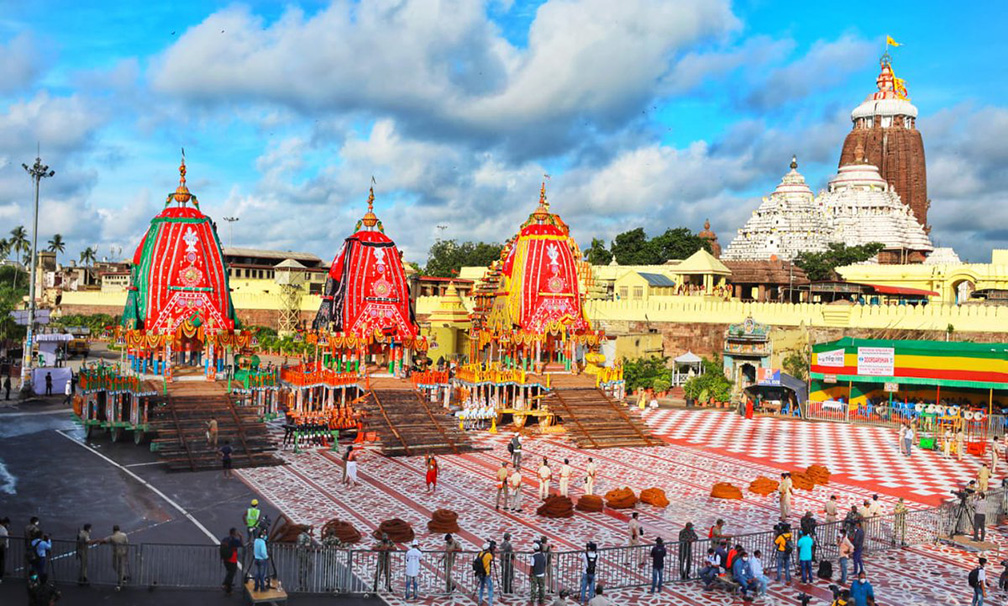
By Vinay Nalwa
Nestled in the spiritual heart of Puri, Odisha, the Jagannath Temple stands as a testament to devotion, tradition, and history. The temple is not merely a structure of stone and mortar; it is a living chronicle of Odisha’s rich cultural heritage, a saga recorded meticulously in the Madala Panji. This ancient chronicle narrates the historical events related to Lord Jagannath and the temple, weaving a tapestry of faith and legend that has endured through the centuries.
One of the most astonishing aspects of the Jagannath Temple is its colossal kitchen, reputed to be the largest in the world. Every day, this kitchen prepares food for 25,000 devotees, and during festivals, it caters to an astounding 100,000 people. This culinary marvel operates seamlessly, symbolizing the temple’s spirit of hospitality and the divine abundance of Lord Jagannath.
The temple is also a hub of diverse traditions, with 36 communities rendering specific hereditary services to the deities. With 6000 priests serving in various capacities, the temple is a beacon of spiritual activity. Atop the temple sits the Nila-Chakra, an alloy wheel of eight metals. This sacred wheel is adorned with a new flag every day, and on every Ekadashi, a lamp is lit beside it, illuminating the sanctity of the temple.
The Rath Yatra, or the Chariot Festival, is a magnificent spectacle that dates back to the 12th century, instituted by the Ganga dynasty. This festival gained early international recognition, with Friar Odoric of Pordenone documenting it in the early 14th century. During the Rath Yatra, the deities of Jagannath, Balabhadra, and Subhadra leave their sanctum and travel to the Gundicha Temple, a journey of three kilometers. The massive chariots, built anew each year, are pulled by throngs of devotees, embodying the unity and fervor of the faithful.
The grandeur of the Rath Yatra procession is unparalleled, with three towering chariots rolling down the Bada Danda, or the Grand Avenue of Puri, towards the Gundicha Temple. This vibrant festival is not only a religious event but also a cultural phenomenon, giving rise to the English word “juggernaut,” signifying an unstoppable force.
Historically, the Jagannath Temple has withstood numerous invasions and plundering, as recorded in the Madala Panji. Despite the attempts to dismantle its sanctity, the temple’s resilience is a testament to the unwavering faith of its devotees. For instance, in 1692, Mughal Emperor Aurangzeb ordered the temple’s closure, but it was reopened shortly after his death in 1707.
The temple’s sacred grounds have been graced by numerous revered acharyas and saints, including Adi Shankara, Guru Nanak, and Sri Chaitanya Mahaprabhu. Their visits underscore the temple’s significance as a spiritual nexus, drawing pilgrims from diverse traditions to seek divine blessings.
A unique symbol of the temple is the Nila Chakra, a blue discus made of eight metals, perched atop the temple’s shikhara. This revered icon is an emblem of divine protection and is accorded the same sanctity as the deities themselves. The daily ritual of hoisting a new flag on the Nila Chakra reflects the temple’s living traditions and the perpetual renewal of faith.
The Baisi Pahacha, or the flight of twenty-two steps, leads into the temple complex. The steps are flanked by the statues of Jaya and Vijaya, the celestial gatekeepers. The entrance, adorned with the idol of Patitapavana Jagannath, symbolizes the temple’s inclusivity, offering solace to all, including those who were once deemed untouchable.
The universality and grandeur of the Rath Yatra transcend mere celebration; it is a profound spiritual journey. During this festival, the deities descend from their celestial abode, mingling with humanity in an extraordinary display of divine love and compassion. This unique confluence of the divine and the mortal realm epitomizes the essence of Odia spirituality, where gods and humans unite in a joyous celebration of life and devotion.
The Jagannath Dham and the Rath Yatra stand as eternal beacons of faith, resilience, and unity. They remind us of the timeless traditions that bind us to our cultural roots and the enduring power of devotion that transcends the barriers of time and space.
(The writer is an author &columnistand her latest book is Blood in the Sea: The Dark History of Hindu Oppression in Goa)